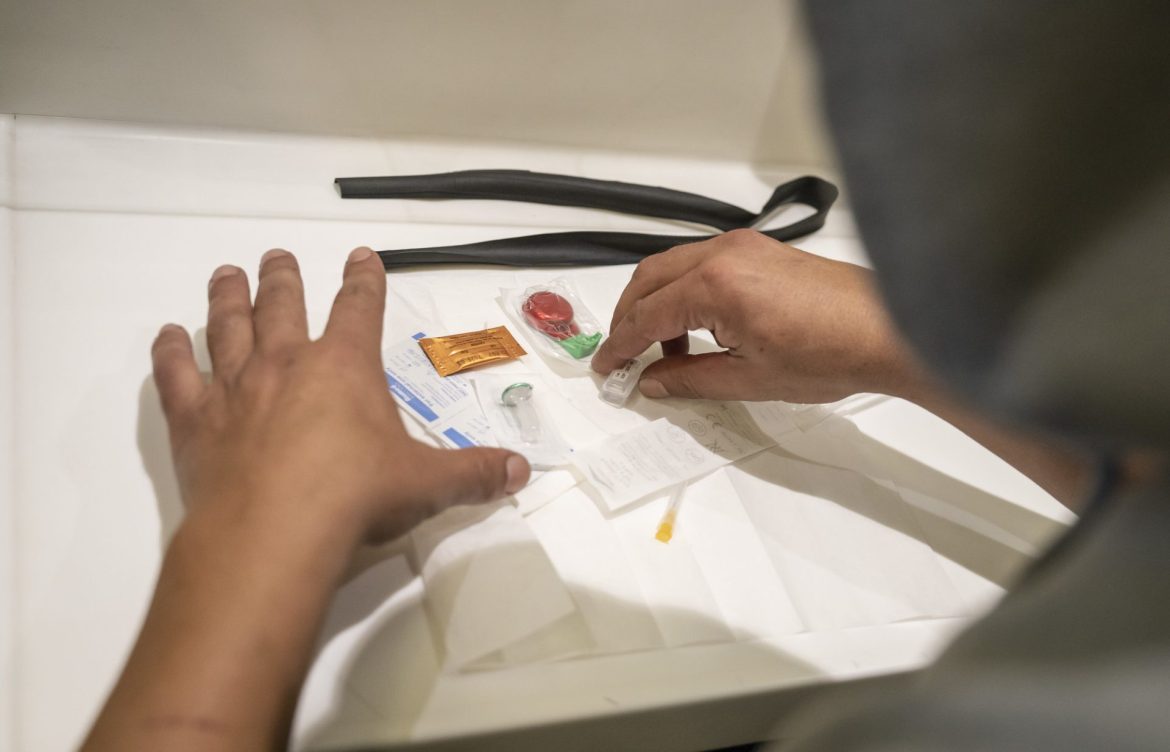57 million people worldwide are infected with the HCV virus (hepatitis C), but only 21% (15.2 million) have been diagnosed.

Picture of syringes and other disposable medical supplies provided to people using drugs at controlled consumption centres. By Conor Ashleigh – ©2023 – INHSU.
Containing hepatitis C is a global goal. Although countries such as Spain have made very significant achievements in preventing and treating hepatitis C, the progress is not too fast.
However, knowing you are infected is not the same as receiving treatment.
Ten years after the advent of direct-acting antiviral drugs that eliminate viruses from the body, only about 62% (9.4 million) of diagnosed patients receive such drugs.
The World Health Organization (WHO) has set a goal that viral hepatitis will no longer pose a threat to public health by 2030, but this goal is still far from being achieved.
Only Egypt has announced that it will achieve the goal of 90% of the population being diagnosed and at least 80% of the population receiving treatment that year.
Egypt’s transformation from one of the world’s hepatitis C hotspots to declaring it is on the path to eliminating the disease has raised hopes, as has Spain, the country with the most hepatitis C in the world. Antiviral drug coverage is highest among people who inject drugs.
In fact, Spain is one step away from meeting the World Health Organization’s goals on hepatitis C, which it was already on track to achieve before the pandemic. Currently, there are only about 20,000 people left who need treatment and cure. It is expected that if the age screening system is implemented in all autonomous regions and high-risk groups, this public health problem will disappear within one or two years.
Containing hepatitis C in Spain is becoming a reality.
But at the global level, there is still a long way to go. How to achieve this has been the focus of this week’s 11th International Conference on Drug User Health and Hepatitis (INHSU 2023) in Geneva, bringing together some 700 experts, healthcare providers, researchers and policymakers and drug users By. 40% of people in this group are affected by the virus.
Unequal access to medicines
Among hundreds of studies presented at IHSU 2023, one will be published later this year in The Lancet Gastroenterology and Hepatology, which lays out in black and white the inequalities in access to antiviral drugs, data from 160 countries.
Although direct-acting antiviral drugs are registered in 87% of low- and middle-income countries, only half subsidize these drugs to make them affordable for affected populations.
Study co-author Jason Grebely from the Kirby Institute at the University of New South Wales lamented that among countries that do not provide these measures, Nigeria and Ethiopia rank seventh and 13th respectively globally in terms of the number of people affected. Bit. In Australia.
“If people living with HCV can’t get a treatment, what’s the point of a treatment?” asked Emma Day, executive director of the conference, which called on governments to provide access to life – and save medicines.
The health of drug users is the most pressing challenge
An estimated 40% of the 14.8 million drug users are infected with the hepatitis C virus.
Detecting infections, preventing new infections and making available treatments available should be a global priority, but if patients don’t stop drinking or taking drugs, some countries perpetuate stigma and restrict access to these medicines, violating WHO recommendations.
Improving access to health for these individuals is one of the great needs of IHSU participants.
This will only happen if we stop criminalizing and stigmatizing people who use drugs, and take a pragmatic stance that focuses on improving the quality of life for people who use drugs.
At least, that’s the view of Ruth Dreifuss, former president of the Swiss Confederation, founding member of the Commission on Global Drug Policy and a great promoter of the Swiss consumption paradigm shift, one of the earliest one. In the 1980s and 1990s, the state introduced consumption supervision offices.
Such measures, in addition to improving their social situation, also provide treatment opportunities for people with HIV or hepatitis C, thereby significantly reducing their numbers.
“The illusion of a world without drugs must end and be replaced by pragmatism,” asks Dreyfus, who advocates replacing the black market of drug production with a government-produced system. Most importantly, understand that the health of drug users must be protected.
The conference gave them a voice and became their meeting point.
Angela Mc Bride of the South African Association called for a focus on reducing harm to consumer health. “The priority is to guarantee human rights in health matters. “Provide syringes, shelter, showers, humanity…and someone to talk to,” he asked.
Without removing these barriers that can reduce hepatitis C mortality among drug users, the WHO’s goal of stopping hepatitis C will inevitably be missed.


